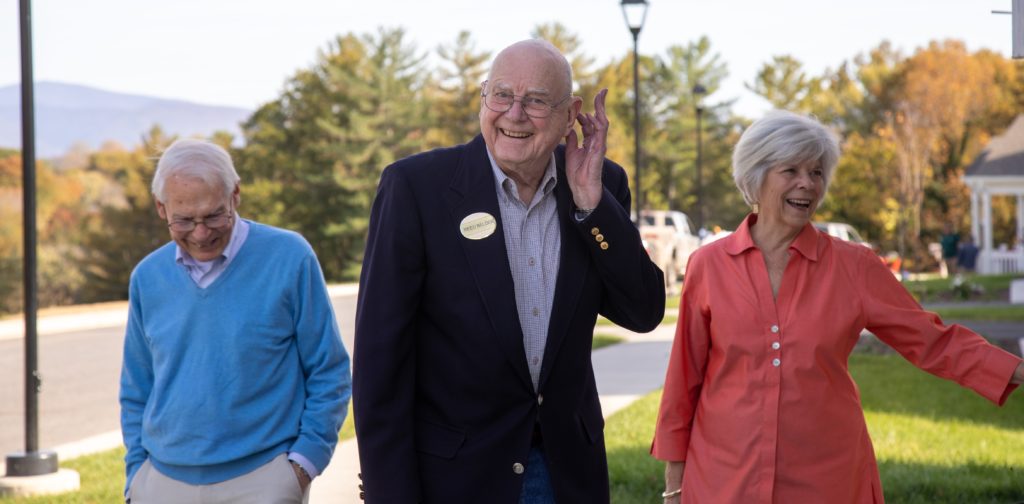October 29, 2020 —Let’s take a ride north on US Rt. 11, six miles to the first settled community in Rockbridge County – Timber Ridge. The first thing you’ll see is the Sam Houston Wayside. Stop and read the commemorative plaque. Now turn right just past the wayside and park near the stone church on your right.
John Mackey, born in Glasgow, Scotland in 1703, made his way down the Wagon Road over the years 1725-27 in search of a place to settle. He was one of the first Scotch-Irish to arrive, and before long there were McClungs, McDowells, Alexanders, Lyles, Houstons, and many more. In 1749 they established the Timber Ridge Presbyterian Church, housed in a log building until 1756, when the stone church you see today was constructed. The men cut and set the stone, while the women, on horseback, brought sand for the mortar from the South River 5 miles to the east.
1749 also saw the formation of the Augusta Academy in a log building near here. Renamed Liberty Hall Academy in 1776, it moved to Lexington in 1782, where it eventually became the Washington and Lee University.
In 1752 Ned Tarr, a freed slave and blacksmith, bought, with his Scottish wife, 270 acres of land on Mill Creek facing the Wagon Road. In future years this property would become Maple Hall. Tarr and his wife became members of the church; his name appears on the call for Pastor Brown to the Timber Ridge Presbyterian Church in 1755.
Robert Houston, an early settler of note, purchased two sections from Benjamin Borden: one in 1740 to be his homestead, and one in 1742, of which 20 poles of land were dedicated to the church. That property was purchased in the early 1840’s by Horace Thompson, an ARP Church minister. In 1848, Thompson built Church Hill, the large house visible south of the church. Church Hill is, today, in the hands of the 6th generation of Thompsons and is now a B&B.
The ARP Church one sees today, across the road from the stone church, was established by some members of the stone church’s congregation following a dispute over the liturgy. Horace Thompson became their first minister. Separate services for the two factions continued in the stone church until completion of the ARP Church building in 1857.
Before leaving this spot, it is worth reading the inscription on John Mackey’s (1703-1774) gravestone near the stone church.
Turning south on Rt. 11 for the return drive to Lexington, one almost immediately passes Maple Hall on the right, built in 1855 by John Gibson. In contemplating the construction of his new house, Gibson observed Thompson’s Church Hill across the road, and determined to build something larger – hence the 3-story structure one sees today. In the era of stage coaches both Church Hill and Maple Hall were stops.
Just below the entrance to I-81, turn right on State Rt. 717 (McClure Rd.). Shortly you will see a sign for “Mill Hole” near what is believed to be the remains of the first mill built on that site, probably in about 1800. The Mill Hole sign connotes a swimming area at the foot of the mill where, it is said, Sam Houston swam as a young boy.
Continue on this road for approximately 1 mile to the intersection with Mt. Atlas Road. Turn left for about 300 yards to where the road splits, then take the left branch. Shortly you will see, on your left, a railroad station which has been converted to a residence. Just past the station, turn left into a gravel area. On the right is the preserved Goodman’s store.
Stop here for a moment. You are now on the former right of way for the Valley Railroad. In 1866, the state chartered the Valley Railroad to connect Staunton and Roanoke, with stops in between. The route was not profitable and was taken over by the Baltimore and Ohio that completed the road to Lexington, but went no further. Service to Lexington began in 1883. It ceased in 1942 when the tracks were taken up for the war effort.
The Valley Railroad may have accelerated the development of Timber Ridge, but the area already had well established businesses. The 1871 Business Directory for the State of Virginia indicates a post office, two general stores, a mill, a lawyer, a doctor and a school. By 1893, however, Timber Ridge could boast a cattle dealer, a carpenter, a distiller, three general stores, a planing mill, two grist mills, a doctor and a school. As with all such small villages, the advent of the automobile and, in this case, the loss of rail service in 1942, contributed to Timber Ridge’s subsequent slow decline.
At this point, retrace your steps to Mt. Atlas road and follow it to RT-11. We have finished our exploration of Timber Ridge. I hope you have enjoyed your Rockbridge County trip back in time.
– – by Resident Reed Belden for CONNECTIONS
